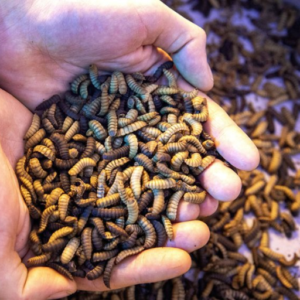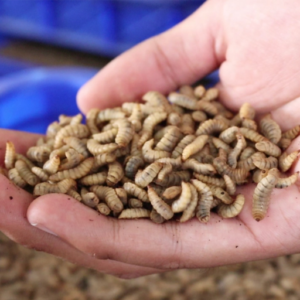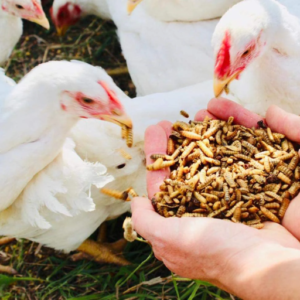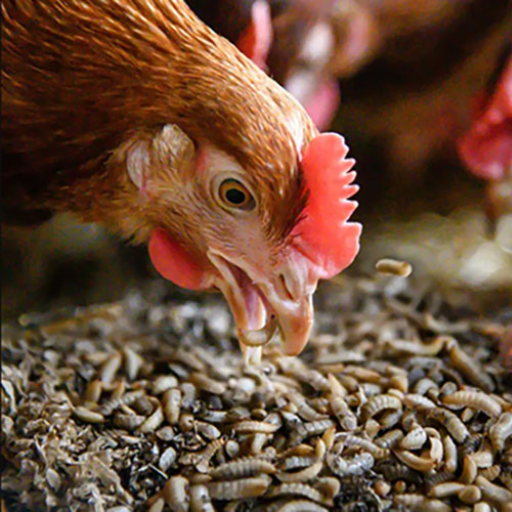The search for sustainable and efficient feed alternatives in poultry farming has become increasingly important. This article examines the potential of Black Soldier Fly (BSF) larvae meal as a healthy and eco-friendly protein for broiler chickens. Traditional feeds like soybeans, cornmeal, or fish meal are becoming more expensive while simultaneously raising ethical concerns over land usage, water consumption, and greenhouse gas emissions associated with their production. In this context, BSF larvae can be seen as an innovative approach that ensures optimal growth performance and reduces waste generation during rearing periods when fed to broilers. The paper discusses the nutritional value of BSF larvae meal, its production methods, and practical applications in poultry farming. It provides useful information for farmers who wish to improve their bird management practices while enhancing sustainability within agriculture.
What Makes Black Soldier Fly Larva a Suitable Feed for Broilers?

Image source: https://www.insectschool.com/
Broiler chickens need a lot of protein, and Black Soldier Fly larvae have that in abundance. The crude protein content of the larvae is usually between 40% and 50%. In addition, they are rich in essential amino acids, making them a complete source of protein. Lauric acid, found in these insects, provides fats that can help with gut health and increase bird immunity. On top of this, converting organic waste into high-quality feed by the BSF lowers feed costs while promoting a circular economy within poultry farming systems. For instance, there will be less landfill waste generated when using BSF-provided foods for chicken and reduced emission of greenhouse gases due to such practices being adopted widely throughout agriculture. Black Soldier Fly larvae seem an excellent choice for broiler diets.
Nutritional Profile of Black Soldier Fly Larva
The nutritional profile of Black Soldier Fly (BSF) larvae is very favorable for broiler chickens. BSF larvae usually have 40-50% protein and a variety of essential amino acids, which makes it an excellent protein source for poultry. Besides this important nutrient, fats are also abundant in BSF larvae, especially lauric acid, which has been linked to improved chicken immune response and gut health. B vitamins, among other key vitamins, calcium, and phosphorus, are provided by the larvae, which are both necessary for overall growth and skeletal development in broilers. Additionally, their ability to digest organic waste increases their nutrient density and reduces feed costs, thus providing a sustainable alternative to poultry nutrition.
Benefits of Black Soldier Fly Larva in Chicken Feed
There are many benefits to using Black Soldier Fly larvae as chicken feed. To begin with, BSF larvae serve as a sustainable protein source that can considerably decrease dependence on traditional feed ingredients, reducing costs for poultry producers. With their high protein content and presence of beneficial fatty acids, the organisms help achieve better growth rates and overall health in broilers. Moreover, including BSF larvae in feeds improves the feed conversion ratio, allowing chickens to put on weight more efficiently. Besides nutritional value addition, BSF insects contribute towards waste management solutions by transforming organic by-products into premium feeds, thereby fostering a circular economy. Finally, less greenhouse gas emissions and reduced waste sent to landfills during poultry farming are some ways in which BSF assists in reducing its environmental impact.
Comparing Black Soldier Fly Larvae Meal with Traditional Poultry Feed Ingredients
Compared to traditional poultry feed ingredients such as soybean meal and fish meal, the black soldier fly (BSF) larva meal stands out because of its unique nutrient profile and sustainable production methods. To begin with, BSF larvae meal has an exceptionally high protein content of over 40%, comparable or higher than that found in fishmeal. It also contains essential amino acids required for poultry growth and development but may be limited to plant-based proteins like soybean meal.
On the other hand, BSF larvae have a fat content rich in beneficial fatty acids such as lauric acid that can enhance gut health and improve immune response. Though traditional feeding materials are nutritious, they can bring about environmental issues related to their production and sourcing. In contrast, BSF larvae can be generated from organic waste materials, encouraging more sustainable feeding options. Also, incorporating BSF larvae into chicken diets may help lower the overall carbon footprint of bird farming, aligning with modern agriculture’s shift towards sustainability. All in all, back soldier fly larva meals provide an attractive alternative to conventional feed sources by offering high nutritional value and greater ecological advantages.
How Does Larvae Meal Affect Broiler Chicken Growth and Performance?

Broiler chicken diets have been found to impact growth and development rates significantly. Compared to poultry fed conventional feedstuffs, these animals tend to gain weight more when provided with BSF larvae meal. The muscle-building properties of this meal can be credited to its high protein and essential amino acid content. Supplementing broiler chicken diets with BSF larvae may also enhance feed conversion efficiency by including beneficial fatty acids that increase weight gain per unit of consumed feed. In addition, it has been shown that feeding broilers BSF larvae contribute to improved gut health, fostering more efficient nutrient absorption and resulting in healthier birds overall. Applying BSF larvae meals is an excellent tool for promoting sustainable agriculture while increasing growth performance among poultry species raised for meat production purposes.
Impact on Feed Intake and Conversion Ratio
Poultry diets that include Black Soldier Fly (BSF) larvae meal greatly affect feed intake and conversion ratios. Broilers fed with BSF larvae are likely to consume more than those fed on conventional feeds because the taste and palatability of BSF larvae are better than the latter. In turn, this increases overall weight gain and efficiency. Studies have also shown that when broilers are fed on diets containing larvae meal, their feed conversion ratio improves as they convert feed to weight more efficiently. It optimizes feeding efficiency and supports healthy growth owing to its high nutritional value, which consists of protein and essential fatty acids, among other nutrients. Therefore, it reduces poultry production costs by improving economic viability through enhanced conversion rates and cheaper feeds, supporting better growth performance.
Broiler Growth Performance on Larvae-Based Diets
Several studies have reported positive findings regarding broiler growth performance on diets based on larvae. This can be attributed to BSF larvae’s high protein and essential amino acids, which promote muscle development and overall growth. In addition, nutrient digestion in BSF larvae is much more effective than conventional feed sources. Studies show that chickens fed with BSF larvae are healthier and better able to cope with stress. Hence, using black soldier flies as chicken food might improve production while ensuring sustainability in agriculture.
Carcass Characteristics of Broiler Chickens Fed Larvae Meal
Broiler chicken carcass characteristics fed with larvae meal, especially from Black Soldier Fly (BSF), are better quality than those given conventional feeds. This is shown in the dressing percentages, which are often higher for broilers kept on diets based on larvae, indicating that there is more edible meat per unit live weight. Furthermore, these birds usually deposit less fat, leading to healthier carcasses. BSF-larvae-meal-fed broiler meat has also been found to be more tender and juicy with better flavor profiles. These characteristics satisfy consumer needs and provide the poultry industry with sustainable and nutritious options for meat production. Thus, it can be concluded that besides improving growth performance, feeding BSF larva meal to broilers positively affects carcass traits, which aligns with current trends toward healthier food sources.
What Are the Optimal Inclusion Levels of Black Soldier Fly Larvae Meal in Broiler Diets?

It is important to evaluate how much Black Soldier Fly (BSF) larvae meal should be included in broiler diets so that growth performance can be maximized, health benefits are ensured, the diet’s palatability is maintained, and nutrients are well balanced. Levels between 5% to 15% will not adversely affect feed intake and total growth. Several experiments have found that including ten percent gives the best feed conversion ratios and carcass qualities. The optimal amount for a specific situation might depend on different things like breed type or other ingredients in the diet and environmental conditions particular to the area being studied; therefore, producers should run their tests before deciding what works best for them.
Studies on BSFL Inclusion Levels in Broiler Diets
Several studies have shown the effectiveness of Black Soldier Fly (BSF) larvae meal in chicken diets, regardless of the level of inclusion used. The first study published in the Journal of Animal Science showed that 10-15% additions significantly increase growth rates and feed efficiency without negatively impacting health. An article in Animal Feed Science and Technology suggests that even lower levels (such as 5%) can work, which means that higher amounts should also be considered depending on how much more is added to a diet already containing this ingredient at some lesser percentage point value within its range specified in previous research studies. Finally, Frontiers in Veterinary Science presents a review stating that different breeds require different amounts based on age. So one size does not fit all when trying to get optimal results from using BSF larvae substitutes for conventional protein sources like soybean meal or fish meal during poultry production processes involving broilers raised under varying conditions throughout different regions worldwide, including but not limited to North America Europe Australia Africa Asia etcetera.
Optimal Inclusion Level for Growth and Health
To find the best inclusion level of Black Soldier Fly larvae in chicken feed, it has been found that including them at a rate between 10% and 15% usually gives good results. This range not only improves feed conversion ratios but also contributes positively to the overall health of broilers. The British Poultry Science journal suggests that optimal inclusion levels can vary depending on factors such as age or nutritional needs of birds fed with BSFL because they affect performance efficiency differently. Therefore, production trials should continue while considering local circumstances since what works well for one farm may not work so well for another.
Effects of High Inclusion Levels on Broiler Performance
Broiler diets can have varying effects on performance with high inclusion levels of black soldier fly larvae (BSFL). Studies suggest that BSFL more than 15% may be beneficial, such as increasing protein intake and improving gut health. Still, it also poses challenges like lowering palatability and causing nutrient imbalances. Overly high levels can hurt feed intake, decreasing the growth rate overall, according to a study published by Poultry Science. The Journal of Animal Science research also shows that these extreme amounts could lead to essential amino acid imbalances affecting the birds’ meat quality and general welfare. Consequently, BSFL management needs to be done carefully to avoid harming their use while still gaining from them.
How can Black Soldier Fly Larvae Meal be incorporated into Broiler Chicken Diet Formulations?

To successfully integrate Black Soldier Fly larvae meal (BSFL) in broiler chicken diets, it is important to start slowly. Replace a small percentage of traditional protein sources such as soybean or fish meal with BSFL, ideally between 5-10%. Watch the birds’ feed intake and overall performance closely to determine if they are adjusting well to the new diet. Gradually increase the inclusion rate according to their response, but do not exceed 15% as this may negatively affect them. It is also important to balance out other ingredients within the diet so that its overall nutritional profile remains constant, especially concerning essential amino acids and vitamins. You should regularly evaluate growth performance metrics, which will help you refine your formulation for better results.
Formulating Diets with Black Soldier Fly Larvae Meal
Regarding diets containing Black Soldier Fly larvae meal (BSFL), it is crucial to consider its nutritional composition and how it interacts with other feed ingredients. Poultry can obtain a potent protein source from BSFL due to their high levels of protein, healthy fats, and important nutrients. A good method starts by replacing 5-10% of traditional proteins, as previously stated, and then gradually increasing while observing the bird’s acceptability or growth rate. To enhance this overall diet balance, combine it with another protein source with a complementary amino acid profile. Also frequent chemical analysis should be done so that dietary formulations are adjusted accordingly which will ensure inclusion of BSFL promotes optimal performance and health status among broiler chickens. In addition, regular monitoring should be done, enabling adjustments in feeding strategies based on different stages of development and nutritional requirements for the birds.
Balancing Nutrients and Cost in Broiler Diets
Strategically balancing nutrients and cost in broiler diets requires innovation. In this sense, the nutritional quality should not be compromised for economic feasibility. Regarding protein sources, only the best should be considered, but all this must consider feed conversion ratio (FCR). This is determined by looking at what local feeds can provide, thus cutting expenses without compromising their nutrient contributions. Moreover, using enzymes or probiotics as additives will help with gut health, leading to better growth performance without increasing costs. Additionally, consistent monitoring of prices for different types of animal feeds will assist nutritionists in making more informed choices about how they formulate profitable diets for poultry farmers and themselves. Including these innovations in dietary formulations can improve broiler production systems’ profitability over time through continuous adjustments based on changing ingredient availability/price levels.
Practical Considerations for Farmers and Feed Producers
Several practical considerations should be considered when farmers are formulating broiler chicken diets. Firstly, it is essential to understand the nutritional requirements of the particular strain of broilers being reared because different breeds may grow and develop differently. Secondly, local feed suppliers can be used to get access to fresh, inexpensive ingredients, which will help maintain a balance between nutritive value and economic viability. Automatic feeders and precision feeding systems are also advanced feeding techniques that can help ensure chickens get the right amounts of feed, thus reducing wastage and maximizing growth. Regular training on nutrition from reliable sources or field testing for ingredient efficacy can give researchers useful ideas concerning better formulation while adhering to proper animal husbandry practices.
What Are the Environmental and Economic Benefits of Using Black Soldier Fly Larvae Meal?

The black soldier fly larvae (BSFL) meal is a valuable feed ingredient for broiler chickens because it has many environmental and economic benefits. BSFLs are environmentally friendly in that they efficiently convert organic waste into high-quality protein from different substrates while simultaneously reducing waste. This process aids in waste management and minimizes landfill use, which positively impacts the environment. On an economic level, BSFL meals can be cheaper than conventional protein sources since their production is often based on discarded food or agricultural by-products, reducing overall feed costs. Moreover, using BSFL will improve the nutritional profile for poultry diets, thus encouraging healthier growth rates with better feed conversion ratios that increase farmers’ profitability.
Reduction in Feed Costs
The cost of poultry feed can be drastically reduced by putting black soldier fly larvae (BSFL) meal as a protein source in broiler chicken feed. The use of BSFL reduces dependence on traditional protein sources such as soybean or fish meal, which are more expensive and subject to market variations. According to the United Nations Food and Agriculture Organization’s website and other industry publications, BSFL production is less resource-intensive and consumes low-value organic waste, thereby reducing costs further. In addition, research shows that incorporating BSFL not only cuts down feed costs but also boosts the overall efficiency of the food, leading to improved weight gain and lower total feed conversion ratios. This combination of expense savings and superior growth performance makes it an attractive option for sustainable poultry production.
Sustainability and Environmental Impact
Black soldier fly larvae (BSFL) feed in poultry brings economic gains and enhances environmental sustainability. Organic waste recycling is part of BSFL production, decreasing landfill space use and greenhouse gas emissions from waste decomposition. According to the Food and Agriculture Organization (FAO), converting waste into animal feed reduces the load of organic waste and fosters circular economy principles in agriculture. Moreover, compared to conventional livestock feeds, BSFL farming uses less land and water, thus being more resource-efficient. Its environmental advantages are clear as it significantly contributes to lowering the ecological footprint of poultry farming while providing a sustainable animal protein source.
Supporting Local Economies and Waste Recycling
Integrating black soldier fly larvae (BSFL) production into poultry feed systems increases sustainability, generates employment opportunities in waste recycling, and boosts local economies. To reduce waste and encourage resource efficiency, BSFL producers can collaborate with local businesses involved in organic waste collection. Moreover, the BSFL industry has the potential to create small farms that will promote innovation and entrepreneurial activities at the community level. Therefore, income will be generated for these communities. Additionally, since BSFL production changes low-cost organic waste into high-quality feed, the costs of poultry farming are reduced. This supports local food systems that depend less on imported feeds while enhancing regional food security.
Frequently Asked Questions (FAQs)
Q: What are the benefits of using black soldier fly larvae meal in broiler chicken diets?
A: Black soldier fly larvae meal in broiler chicken diets offers numerous benefits, including improved growth performance, better feed conversion ratios, and enhanced carcass quality. Its high protein and crude fat content make it a highly nutritious alternative to traditional feed ingredients like soybean and fish meal.
Q: How does the dietary inclusion of black soldier fly larvae meal affect the growth of broiler chicks?
A: Dietary inclusion of black soldier fly larvae meal significantly enhances the growth of broiler chicks. Studies have shown that broiler chicks fed diets containing BSFLM exhibit better weight gain and feed efficiency than those without it.
Q: What is the nutritional composition of black soldier fly larvae meal?
A: Black soldier fly larvae meal’s nutritional composition includes high protein and crude fat levels alongside essential amino acids and minerals. This makes it a valuable ingredient in animal diets, supporting optimal growth and health.
Q: Can black soldier fly larvae meal replace traditional protein sources like soybean and fish meal in broiler chicken diets?
A: Black soldier fly larvae meal can effectively replace traditional protein sources like soybean and fish meal. Research has shown that broiler chickens fed diets with increasing levels of BSFL dietary inclusion perform as well as, or better than, those on control diets containing traditional protein sources.
Q: What are the effects of BSFL dietary inclusion on the carcass quality of broiler chickens?
A: Including BSFL in broiler chicken diets can positively impact carcass quality. Chickens fed with black soldier fly meal typically exhibit improved muscle development, better meat texture, and higher overall quality.
Q: How much black soldier fly larvae meal should be included in the experimental diets of broiler chickens?
A: The inclusion rates can vary, but studies suggest that up to 15-20% dietary inclusion of black soldier fly larvae meal yields significant growth and health benefits in broiler chickens without compromising performance.
Q: Are there any differences in the performance of broiler chickens on finisher diets containing black soldier fly larvae meal?
A: Broiler chickens on finisher diets containing black soldier fly larvae meal show similar or enhanced performance compared to those without it. The finisher diets with BSFLM contribute to maintaining growth rates and improving feed efficiency as chickens approach market weight.
Q: What impact does the crude fat content of black soldier fly larvae meal have on broiler chicken diets?
A: The high crude fat content in black soldier fly larvae meal provides a concentrated energy source, supporting better growth and feed conversion. It can reduce the need for additional fat sources in the diet, simplifying feed formulations.
Q: How does including black soldier fly larvae meal in broiler chicken diets affect feed cost?
A: Including black soldier fly larvae meal in broiler chicken diets can help reduce feed costs, especially if sourced locally. It offers a cost-effective alternative to traditional protein sources like fish meal, which are often more expensive and less sustainable.













